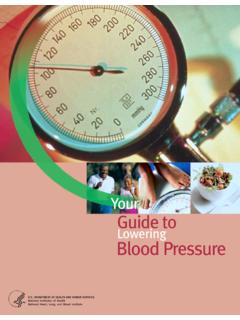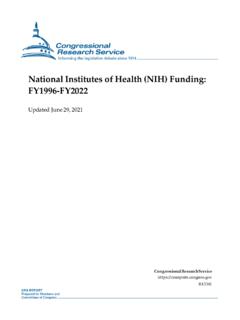Transcription of Glance at a - National Cancer Institute
1 Theory at a Glance A Guide For health Promotion Practice (Second Edition) DEPARTMENT OF health AND HUMAN SERVICES National Institutes of health Foreword Adecade ago, the first edition of Theory at a Glance was published. The guide was a welcome resource for public health practitioners seeking a single, concise summary of health behavior theories that was neither overwhelming nor superficial. As a government publication in the public domain, it also provided cash-strapped health departments with access to a seminal integration of scholarly work that was useful to program staff, interns, and directors alike. Although they were not the primary target audience, members of the public health research community also utilized Theory at a Glance , both as a quick desk reference and as a primer for their students. The National Cancer Institute is pleased to sponsor the publication of this guide, but its relevance is by no means limited to Cancer prevention and control.
2 The principles described herein can serve as frameworks for many domains of public health intervention, complementing focused evidence reviews such as Centers for Disease Control and Prevention s Guide to Community Preventive Services. This report also complements a number of other efforts by NCI and our federal partners to facilitate more rigorous testing and application of health behavior theories through training workshops and the development of new Web-based resources. One reason theory is so useful is that it helps us articulate assumptions and hypotheses concerning our strategies and targets of intervention. Debates among policymakers concerning public health programs are often complicated by unspoken assumptions or confusion about which data are relevant. Theory can inform these debates by clarifying key constructs and their presumed relationships. Especially when the evidence base is small, advocates of one approach or another can be challenged to address the mechanisms by which a program is expected to have an impact.
3 By specifying these alternative pathways to change, program evaluations can be designed to ensure that regardless of the outcome, improvements in knowledge, program design, and implementation will occur. I am pleased to introduce this second edition of Theory at a Glance . I am especially impressed that the lead authors, Dr. Barbara K. Rimer and Dr. Karen Glanz, have enhanced and updated it throughout without diminishing the clarity and efficiency of the original. We hope that this new edition will empower another generation of public health practitioners to apply the same conceptual rigor to program planning and design that these authors exemplify in their own research and practice. Robert T. Croyle, Director Division of Cancer Control and Population Sciences National Cancer Institute Spring 2005 Acknowledgements The National Cancer Institute would like to thank Barbara Rimer and Karen Glanz , , authors of the original monograph, whose knowledge of healthcommunications theory and practice have molded a generation of health promotion practitioners.
4 Both have provided hours of review and consultation, and we are grateful to them for their contributions. Thanks to the staffs of the Office of Communications, particularly Margaret Farrell, and the Division of Cancer Control and Population Sciences and Kelly Blake, who guided this monograph to completion. We appreciate in particular the work of Karen Harris, whose attention to detail and commitment to excellence enhanced the monograph s content and quality. Tables and Figures Table of Contents Introduction viii Audience and Purpose 1 Contents 1 Part 1: Foundations of Theory in health Promotion and health Behavior 3 Why Is Theory Important to health Promotion and health Behavior Practice? 4 What Is Theory? 4 How Can Theory Help Plan Effective Programs? 4 Explanatory Theory and Change Theory 5 Fitting Theory to the Field of Practice 5 Using Theory to Address health Issues in Diverse Populations 7 Part 2: Theories and Applications 9 The Ecological Perspective: A Multilevel, Interactive Approach 10 Theoretical Explanations of Three Levels of Influence 12 Individual or Intrapersonal Level 12 health Belief Model 13 Stages of Change Model 15 Theory of Planned Behavior 16 Precaution Adoption Process Model 18 Interpersonal Level 19 Social Cognitive Theory 19 Community Level 22 Community Organization and Other Participatory Models 23 Diffusion of Innovations 27 Communication Theory 29 Media Effects 30 Agenda Setting 30 New Communication Technologies 31 Part 3: Putting Theory and Practice Together 35 Planning Models 36 Social Marketing 36 PRECEDE-PROCEED 39 Where to Begin.
5 Choosing the Right Theories 43 A Few Final Words 44 Sources 48 References 49 Table 1 Table 2 Table 3 Table 4 Table 5 Table 6 Table 7 Table 8 Table 9 Table 10 Table 11 Figure 1 Figure 2 Figure 3 Figure 4 Figure 5 Figure 6 Figure 7 Figure 8 Figure 9 Figure 10 Tables An Ecological Perspective: Levels of Influence 11 health Belief Model 14 Stages of Change Model 15 Theory of Planned Behavior 17 Social Cognitive Theory 20 Community Organization 24 Concepts in Diffusion of Innovations 27 Key Attributes Affecting the Speed and Extent of an Innovation s Diffusion 28 Agenda Setting, Concepts, Definitions, and Applications 31 Diagnostic Elements of PRECEDE-PROCEED 42 Summary of Theories: Focus and Key Concepts 45 Figures Using Explanatory Theory and Change Theory to Plan and Evaluate Programs 6 A Multilevel Approach to Epidemiology 10 Theory of Reasoned Action and Theory of Planned Behavior 18 Stages of the Precaution Adoption Process Model 19 An Integrative Model 21 Sociocultural Environment Logic Framework 26 An Asthma Self-Management Video Game for Children 33 Social Marketing Wheel 38 The PRECEDE-PROCEED Model 40 Using Theory to Plan Multilevel Interventions 46 viii T H E O R Y AT A G L A N C E Introduction This monograph, Theory at a Glance : Application to health Promotion and health Behavior (Second Edition), describes influential theories of health -related behaviors, processes of shaping behavior, and the effects of community and environmental factors on behavior.
6 It complements existing resources that offer tools, techniques, and model programs for practice, such as Making health Communication Programs Work: A Planner s Guide, i and the Web portal, Cancer Control PLANET (Plan, Link, Act, Network with Evidence-based Tools).ii Theory at a Glance makes health behavior theory accessible and provides tools to solve problems and assess the effectiveness of health promotion programs. (For the purposes of this monograph, health promotion is broadly defined as the process of enabling people to increase control over, and to improve, their health . Thus, the focus goes beyond traditional primary and secondary prevention programs.) For nearly a decade, public health and health care practitioners have consulted the original version of Theory at a Glance for guidance on using theories about human behavior to inform program planning, implementation, and evaluation. We have received many testimonials about the First Edition s usefulness, and requests for additional copies.
7 This updated edition includes information from recent health behavior research and suggests theoretical approaches to developing programs for diverse populations. Theory at a Glance can be used as a stand-alone handbook, as part of in-house staff development programs, or in conjunction with theory texts and continuing education workshops. For easy reference, the monograph includes only a small number of current and applicable health behavior theories. The theories reviewed here are widely used for the purposes of Cancer control, defining risk, and segmenting populations. Much of the content for this publication has been adapted from the third edition of Glanz, Rimer, and Lewis health Behavior and health Education: Theory, Research, and Practice, 1 published by Jossey-Bass in San Francisco. Readers who want to learn more about useful theories for health behavior change and health education practice can consult this and other sources that are recommended in the References section at the end of the monograph.
8 I Making health Communication Programs Work ( ) describes a practical approach for planning and implementing health communication efforts. ii Cancer Control PLANET ( ) provides access to data and resources that can help planners, program staff, and researchers to design, implement, and evaluate evidence-based Cancer control programs. Audience and Purpose This monograph is written primarily for public health workers in state and local health agencies; it is also valuable for health promotion practitioners and volunteers who work in voluntary health agencies, community organizations, health care settings, schools, and the private sector. Interventions based on health behavior theory are not guaranteed to succeed, but they are much more likely to produce desired outcomes. Theory at a Glance is designed to help users understand how individuals, groups, and organizations behave and change knowledge they can use to design effective programs.
9 For information about specific, evidence-based interventions to promote health and prevent disease, readers may also wish to consult the Guide to Community Preventive Services, published by the Centers for Disease Control and Prevention (CDC) at Contents This monograph consists of three parts. For each theory, the text highlights key concepts and their applications. These summaries may be used as checklists of important issues to consider when planning or evaluating programs or to prompt project teams to think about the range of factors that influence health behavior. Part 1. Foundations of Theory in health Promotion and health Behavior describes ways that theories and models can be useful in health behavior/ health promotion practice and provides basic definitions. Part 2. Theories and Applications presents an ecological perspective on health behavior/ health promotion programs. It describes eight theories and models that explain individual, interpersonal, and community behavior and offers approaches to solving problems.
10 A brief description of each theory is followed by definitions of key concepts and examples or case studies. The section also explores the use of new communication technologies. Part 3. Putting Theory and Practice Together explains how theory can be used in health behavior/ health promotion program planning, implementation, and evaluation. Two comprehensive planning models, PRECEDE-PROCEED and social marketing, are reviewed. 1 INTRO T H E O R Y AT A G L A N C E Foundations of Theory in health Promotion and health BehaviorPart 1 3 PART 1 T H E O R Y AT A G L A N C E 4 T H E O R Y AT A G L A N C E Why Is Theory Important to health Promotion and health Behavior Practice? Effective public health , health promotion, and chronic disease management programs help people maintain and improve health , reduce disease risks, and manage chronic illness. They can improve the well-being and self-sufficiency of individuals, families, organizations, and communities.









